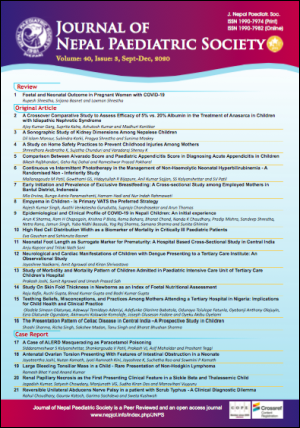A Sonographic Study of Kidney Dimensions Among Nepalese Children
DOI:
https://doi.org/10.3126/jnps.v40i3.29303Keywords:
Child; Kidney; Kidney Disease; UltrasonographyAbstract
Introduction: Any variations in shape or size of either one or both kidneys may indicate sign of its pathology. The study was aimed to determine normal values for renal dimensions among Nepalese children.
Methods: This was a cross-sectional study of the renal dimensions among 211 children. The length, breadth and thickness of kidneys were measured by computerised in built calliper in centimetre by using ultrasound and volume of the kidney was calculated.
Results: The mean values of length, breadth, thickness and volume were 7.05 ± 1.80 cm, 2.95 ± 0.48 cm, 1.35 ± 0.15 cm and 15.09 ± 5.91 cc for right kidneys respectively; and 7.36 ± 1.89 cm, 2.98 ± 1.89 cm, 1.35 ± 0.18 cm and 15.98 ± 6.44 cc for left kidneys respectively. The mean values for length, breadth, thickness and volume of right kidney was 7.57 ± 1.99 cm, 3.11 ± 0.46 cm, 1.38 ± 0.14 cm and 17.38 ± 6.20 cc among boys respectively; and 6.50 ± 1.39 cm, 2.78 ± 0.44 cm, 1.31 ± 0.17 cm and 12.69 ± 4.43 cc among girls respectively. Similarly, these values for length, breadth, thickness and volume of left kidneys were 7.91 ± 2.04 cm, 3.13 ± 0.49 cm, 1.39 ± 0.18 cm and 18.46 ± 6.89 cc among boys respectively; and 6.78 ± 1.52 cm, 2.83 ± 0.45 cm, 1.31 ± 0.17 cm and 13.38 ± 4.73 cc among girls respectively.
Conclusions: It was concluded that mean values for renal length and volume was found to be higher on left side than right side in all age groups. These values for renal breadth and thickness were observed almost same on both sides in all age groups. All measurements of renal dimensions were found significantly higher among boys than girls on both sides. This study has provided the reference values for renal sizes among Nepalese children.
Downloads
Downloads
Published
How to Cite
Issue
Section
License
Authors who publish with this journal agree to the following terms:
Authors retain copyright and grant the journal right of first publication with the work simultaneously licensed under a Creative Commons Attribution License that allows others to share the work with an acknowledgement of the work's authorship and initial publication in this journal.
Authors are able to enter into separate, additional contractual arrangements for the non-exclusive distribution of the journal's published version of the work (e.g., post it to an institutional repository or publish it in a book), with an acknowledgement of its initial publication in this journal.
Authors are permitted and encouraged to post their work online (e.g., in institutional repositories or on their website) prior to and during the submission process, as it can lead to productive exchanges, as well as earlier and greater citation of published work (See The Effect of Open Access).



